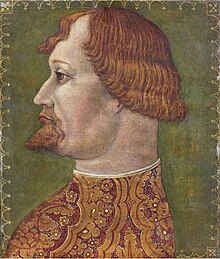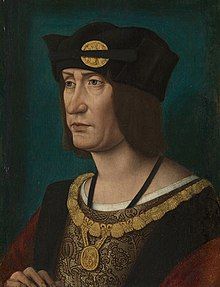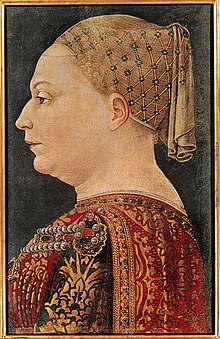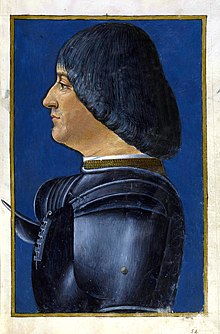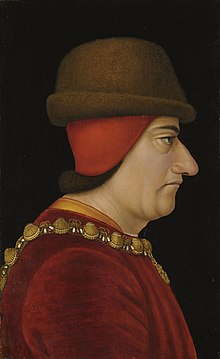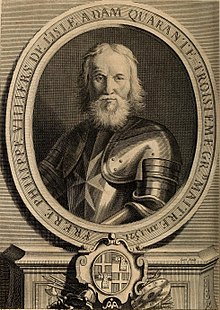Guy Pot
Guy Pot (* around 1428; † before March 31, 1495), also known as Guiot Pot , was a French nobleman from the Pot family , the lord of La Rochepot etc. and for a short time Count of Saint-Pol , who developed from the traditional His family's ties to the House of Burgundy dissolved and - as a distant relative - in the service of Charles de Valois, duc d'Orléans († 1465) and then in the service of Louis XI. King of France entered from 1461 to 1483, who in 1477 briefly enfeoffed him with the county of Saint-Pol and whom he served until 1483 as royal councilor and first chamberlain, seneschal (truchess) of Vermandois and governor of Touraine . Through his ancestor Béatrice Visconti († 1410), Guy Pot had extensive princely relatives and brothers-in-law, which were exceptional for a knightly family, and which reached into the first dynasties of Europe.
Through his daughter Anne Pot, who with Guillaume de Montmorency (* 1453, † 24 May 1531 Chantilly Castle) Baron de Montmorency (1472–1531) and his grandson, the general Anne de Montmorency the first Duke of Montmorency († 12 November 1567) was married, Guy Pot left an important and still existing descendant.
origin
Beginnings in the Limousin region
The French aristocratic family Pot comes from the Limousin region , which is located in the center of France and in the north-western part of the Massif Central and today includes the Corrèze, Creuse and Haute-Vienne departments . It is in this landscape that Guillaume Pot seigneur de Champroy appears around 1220 as the first member of the family to appear in a document. At the beginning of the 15th century the family split into the older line of La Prugne and La Rochepot - to which Guy Pot belongs - and the younger line to Piegu and Rhodes, which - split into several lines - until the end of the 19th century Century flourished. A successful marriage policy was essential for the family's ascent, which began with the oldest known representative, Guillaume Pot, who owes his Champroy estate to his marriage to Blanche (Catherine) du Verdier, the heir to the Hugoness du Verdier, seigneur de Champroy.
Grandfather Régnier Pot
Guy's grandfather Régnier Pot (* around 1362, † July 1432) played an important role in the rise of the family. He was councilor and treasurer of Philip III. Duke of Burgundy (1419–1467), served from 1409 to 1414 as governor of the Dauphiné and from 1411 to 1412 as governor of Languedoc , and as ducal ambassador to Hungary . Thanks to his services, he was taken over by Duke Philip III. Admitted to the order as the second knight in 1430 when the Order of the Golden Fleece was founded.
At the same time, Regnier managed to expand his property considerably, so that he, among others, Mr. von La Prugne, von Thorey , Chamelard (1398), Mélisey (1399), Courcelles-le-Roi , von Vieil-Castel, Cruzy-le-Châtel , Saint- Romain, Maulnes and Champroy, as well as Lord von Bourguignons . In 1403 he acquired around 4000 écus-d'or lordship and castle La Roche-Nolay which he - not exactly modestly - renamed "La Roche-Pot". (Today La Rochepot Castle in the commune of La Rochepot in the Côte-d'Or department in the Bourgogne-Franche-Comté region )
Princely brotherhood
Guy's grandfather Régnier Pot took another step up by marrying Caterina Anguissola, who went to France as the lady-in-waiting of Valentina Visconti , the bride of Louis of Orléans, Duke of Orléans (born March 13, 1372; † November 23, 1407) because Caterina's father, Count Giovanni Anguisola († 1396) from Piacenza , the builder of the Castello di Grazzano Visconti in Vigolzone, was married to Beatrice Visconti (* before 1350, † 1410), from the Visconti dynasty ruling Milan. In doing so, he expanded the relationship and brotherhood of his grandson Guy Pot to include a European and at the same time princely dimension.
Father Jacques Pot
Jacques Pot (* 1399; † 1458), the father of Guy Pot, followed in 1432 as the only son heir to his father in his father's possessions and, in keeping with the land ownership and family tradition, was in the service of the Dukes of Burgundy, namely in that of Duke Philip III. the good man who ruled the extensive estates of his house from 1419 to 1467. Despite his princely relatives through his grandmother Beatrice Visconti, Jacques Pot remained within the traditional framework, was an advisor and chamberlain to Duke Philip III. dedicated himself to his possessions and his large group of children, but did not distinguish himself through outstanding services, so that - unlike his father and his eldest son - he was not accepted into the order of the Golden Fleece. He ⚭ I. Marie de Preuilly († 1421), a daughter of Gilles seigneur de Preuilly († 1412) and Marguerite de Naillac († 1421); ⚭ II. Marguerite de Courtiamble († after 1474), a daughter of Jacques de Courtiamble, seigneur de Commarin and Jacquette de Blaisy;
Life
Princely relatives
Thanks to his great-grandmother Beatrice Visconti, Guy Pot had an unusually extensive and high-ranking relationship for a person of knightly class, since Beatrice Visconti was an illegitimate daughter of Galeazzo II Visconti (* around 1320 - † August 4, 1378) and Malgarola da Lucino. , Her father was co-lord of Milan from 1349 to 1355, lord of Pavia , Como , Novara etc., in 1354 imperial vicar of Milan, Genoa etc., and besides in 1360 builder of the Castello Visconteo in Pavia, a patron of Francesco Petrarca and the founder of the University of Pavia .
Beatrice's half-brother Gian Galeazzo Visconti (1351-1402) became the most powerful representative of his family by eliminating his uncle Bernabò Visconti (* 1323; † 1385) in 1385 and thereby becoming the sole ruler of the extensive territories of his family, which he included around Verona , Vicenza , Padua and Pisa expanded and in 1395 achieved that he was elevated to Duke of Milan and Count of Pavia. At the same time, he created permanent monuments for himself as the builder of the Cathedral of Milan I and the Certosa di Pavia . From his first marriage to Isabella of France († 1342), a daughter of King John II , he had the daughter Valentina Visconti (* 1366, † 1408), who in 1389 with Louis de Valois, duc d'Orléans (* 1372 , † murdered in Paris 23 November 1407), 1386 Duke of Touraine , from 1392 Duke of Orléans etc., a younger brother of the French King Charles VI. , was married.
The relatives of Guy Pot therefore also include their descendants, including:
-
Charles de Valois, duc d'Orléans (* 1394 ; † 1465 ) - Guy's later employer - who lived in English captivity for 25 years after the Battle of Azincourt from 1415, but achieved immortality in France as the master of medieval courtly poetry. His first marriage was to his cousin Isabella von Valois (1389-1409), a daughter of King Charles VI. and widow of King Richard II of England and married third to Maria Duchess of Cleves.
- Johanna von Orléans (* from 1st marriage, 1409, † 432), ⚭ 1421 Duke Johann II. Von Alençon (* 1409, † 1476) (no children)
- Marie Madelaine von Orléans (* 1457 from 3rd marriage, † 1493) ⚭ 1476 Jean de Foix (* † 1500), Count of Étampes (1478–1500), and Vice-Count of Narbonne (1468–1500),
- Germaine (1488–1538) ⚭ Ferdinand II the Catholic, King of Aragón ( House of Trastámara ) (1479–1516)
- Gaston , Duke of Nemours , French general, died in 1512 in the Battle of Ravenna
- Louis XII. King of France from 1498 to 1515, Duke of Milan (1499–1512), titular king of Jerusalem and Sicily (1501–1504) ⚭ 1) 1476 Joanna of France (* 1465, † 1505, daughter of King Louis XI., ⚭ 2) 1499–1514 Anna of Bretagne (was married to the Roman-German King Maximilian I in 1490 ) ⚭ 3) 1514 Mary Tudor (* 1496, † 1533), sister of King Henry VIII of England
,
-
Johann, Count of Angoulême (* 1399 ; † 1467 ), ⚭ 1449 Marguerite de Rohan, baronne de Montberon, (* around 1412, † 1497)
-
Charles Count of Angoulême (* 1459; † 1496) ⚭ Luise of Savoy , daughter of Duke Philip II of Savoy
- Margarete (* 1492; † 1549) ⚭ I. 1509 with Duke Charles IV of Alençon , ⚭ II. 1527 with King Henry II of Navarre
- Franz I (* 1494; † 1547), King of France (1515–1547) ⚭ Claude de France (* 1499, † 1524) daughter of King Louis XII.
- Jeanne (* 1462; † 1520), ⚭ Charles François de Coetivy, Count of Taillebourg ( House of Coëtivy )
-
Charles Count of Angoulême (* 1459; † 1496) ⚭ Luise of Savoy , daughter of Duke Philip II of Savoy
- Marguerite of Orléans, comtesse de Vertus (1423), (* 1406, † 1466), ⚭ 1423 Richard of Bretagne , Count of Étampes (1421–1438), (* 1395, † 1438)
- Catherine of Brittany, dame de Courtenay etc. (* 1428, † 1476) ⚭ 1438 Guillaume de Chalon, (* around 1415, † 1475), Prince of Orange (1463–1475),
- Jean IV de Chalon (* 1443, † 1502) Prince of Orange (1475–1502) ⚭ II. Philiberte de Luxembourg
- Franz von Étampes (* 1435, † 1488) Duke of Brittany (1458–1488) ⚭ II. 1471 Margaret of Foix (* after 1458; † May 15, 1486)
- Catherine of Brittany, dame de Courtenay etc. (* 1428, † 1476) ⚭ 1438 Guillaume de Chalon, (* around 1415, † 1475), Prince of Orange (1463–1475),
- Anne de Bretagne (* 1477; † 1514), Duchess of Bretagne, ⚭ I) 1490 Maximilian I, Roman-German King (* 1459, † 1519), ⚭ II) 1491 King Charles VIII of France (* 1470; † 1498 ), ⚭ III) 1499 King Ludwig XII. of France (* 1462; † 1515)
Other relatives of the Pot family come from Gian Galeazzo Visconti's second marriage to his cousin Caterina Visconti († 1404):
- Giovanni Maria Visconti (* 1388, † 1412) who ruled as 2nd Duke of Milan from 1402 to 1412 . ⚭ 1408 with Antonia Malatesta , daughter of Andrea Malatesta, Lord of Cesena
- Filippo Maria Visconti (* 1392 ; † 1447 ), succeeded his brother from 1412 to 1447 as the third Duke of Milan and had a daughter from his relationship with Agnese del Maino († after August 13, 1447).
- Bianca Maria Visconti (* 1425, † 1468), ⚭ 1441 Francesco I. Sforza , who ruled as the 4th Duke of Milan from 1450.
-
Galeazzo Maria Sforza (1444–1476), 5th Duke of Milan 1466
- Gian Galeazzo Sforza (1469–1494), 6th Duke of Milan 1476, ⚭ 1468, Bona of Savoy (1449–1503), a daughter of Duke Ludwig
- Bianca Maria Sforza (1472–1510) ⚭ 1494 Emperor Maximilian I (1459–1519)
- Anna Sforza (* 1473, † November 30, 1497) ⚭ January 12, 1491 Alfonso I. d'Este (1476–1534)
- (out of wedlock) Caterina Sforza (* 1463, † May 28, 1509)
- Ippolita Sforza (April 18, 1446 - August 20, 1484), ⚭ 1465 Alfonso II of Aragon , King of Naples (1448–1495), ( House of Trastámara )
- Filippo Maria Sforza (1448–1492), ⚭ Konstanze Sforza, daughter of Bosio Sforza
- Sforza Maria Sforza (1451–1479), Duke of Bari
- Ludovico Sforza , called "il Moro" (1451–1508), 7th Duke of Milan (1494–1499)
-
Galeazzo Maria Sforza (1444–1476), 5th Duke of Milan 1466
- Ottaviano Sforza (1458 - 1477)
- Elisabetta Sforza († 1473), ⚭ 1469 Wilhelm VIII. Margrave of Montferrat († 1483)
- Ascanio Sforza (1455–1505), 1484 cardinal
Another - somewhat more distant - relationship between Guy Pot and the French royal family existed through Taddea Visconti (* 1351, † 1381), who as the daughter of Bernabo Visconti was a cousin of Beatrice Visconti. She married Stephan III in 1367 . Duke of Bavaria-Ingolstadt († 1413), whose daughter Elisabeth Duchess of Bavaria as Isabeau de Bavière Charles VI. King of France married and mother of Charles VII. King of France from 1421 to 1461 and grandmother of Louis XI. King of France from 1461 to 1483 and great-grandmother of Charles VIII. King of France from 1483 to 1498.
youth
Guy Pot grew up on his father's estate la Prugne together with his siblings. With his older brother Philippe Pot (* 1428, † 1493), his younger brothers Jacques Pot, seigneur de Thorey († July 7th 1475) during the conquest of Bar-sur-Seine, Georges Pot, Abbot of St-Michel de Tonnerre († 1494); Regnier Pot, knight of the Order of St. John, commander of Chalon and Valence, who fell on the island of Rhodes in the attack of the Ottomans in 1498, for whom his brother-in-law, the grand master of the order, Philippe de Villiers de lÍslle Adam, had a memorial plaque erected in the Archaeological Museum is located in Rhodes. and Louis II Pot (* 1467, † 1505) Abbot of Marmoutier 1498 - 1505, Bishop of Tournai 1498 - 1505 and Bishop of Lectoure in the Département Gers (from 1500 to 1505) and his married sisters Philippine, Antoniette and Edmonde, the nun of Benedictine order and from 1485 prioress of Marcigny- les-Nonnains.
In the shadow of his brother Philippe
Guy Pot was long in the shadow of his eldest brother Philippe Pot (* 1428, † 1493), on whose preferred position the fact that the sovereign - Duke Philip III. the good of Burgundy - acted as his godfather. He made a career at his court, was accepted into the Order of the Golden Fleece in 1461, rose to ducal ambassador in London and in 1473 to colonel-court master of Duke Charles the Bold . He was lord of La Rochepot, La Roche, Châteauneuf, of Givry, Nesle, Saint-Romain, Thorey-sur-Ouche, Meursault and of Châteauneuf-en-Auxois was Philippe Pot after the death of Duke Charles the Bold Binding to the kingdom of the Dukes of Burgundy, as this came into the sphere of influence of her husband, Maximilian I , Archduke of Austria , through the marriage of his daughter Maria of Burgundy (* 1457, † 1482 in Bruges) , and turned to France and entered the service of Louis XI., King of France (1461-1483) , which led to Philippe Pot being excluded from the Order of the Golden Fleece in 1481. To compensate, he was accepted into the French Order of Saint Michel.
In French service
In the service of the Duke of Orléans
Because of the dominance of his brother in the Burgundian domain, Guy Pot tried his luck outside the Duchy of Burgundy and turned to his relative, Duke Charles Duke of Orléans who was a son of his aunt Valentina Visconti. Guy served him as councilor and chamberlain, and in 1447/48 he probably participated in the duke's efforts to implement the claims inherited from his mother to the duchy of Milan, but this failed due to the lack of support from King Charles VII.
On the other hand, he was undoubtedly a witness to the literary activity of the Duke, who is not only regarded as the most important representative of courtly poetry of his time, but also made his court in Blois Castle a literary center by hosting poets from all over France on shorter and longer visits, including Olivier de la Marche , Georges Chastellain Jean Meschinot and, at the end of 1457, François Villon . The meeting of princes in Tours in 1465 was not only for Duke Charles of Orléans, who was there by the new King of France, Louis XI. was publicly humiliated, and died on the way home, but also a turning point for Guy Pot, since he was led by King Louis XI. when the councilor and chamberlain was withdrawn
In the service of King Ludwig XI.
Also to King Ludwig XI. Guy Pot had family connections, because his grandmother Isabeau de Bavière , actually Elisabeth Duchess of Bavaria (* 1370, † 1435), was the daughter of Duke Stephen III. von Bayern-Ingolstadt and his wife Taddea Visconti († 1381), who was a daughter of the Milanese city lord Bernabò Visconti .
Diplomatic missions
For Louis XI. Guy Pot undertook numerous diplomatic missions, in particular to the court of the Dukes of Burgundy and served the king as advisor and Bailli of Vermandois and accompanied the king at his important meeting with Charles the Bold , Duke of Burgundy in the castle of Péronne in Vermandois (today in Somme in the region of Hauts-de-France ), focus was for King Louis XI matter of preventing, to the League of the Public weal (League for the common good) under the leadership of Charles the Bold once more against the king rises and that in the event of an English invasion under King Edward IV - his brother-in-law - Charles would not ally with him. The king's negotiating position was weakened by two further facts: Shortly after the king's arrival in Péronne on October 9, 1468, an uprising against the Burgundian rule broke out on his behalf on his behalf, which was taken as an occasion by Charles the Bold Imprison König and his advisors in Péronne Castle and threaten with death. King Louis XI. and his first chamberlain and advisor, Guy Pot, may also owe their lives to the recommendation of Duke Charles' advisor Philippe de Commynes not to kill them. This - and probably Guy Pot - also contributed to the fact that, despite the lopsided initial situation on October 14, 1468, a reasonably balanced result could be achieved in the Peace of Péronne by approving the wishes of the king with an increased independence of the dukes of Burgundy was bought by the crown of France.
Mentor to the Crown Prince
Guy Pot was founded by King Louis XI. among others, such as the humanist Guy Tardif as an educator for his 1470-born son, the Dauphin Charles. A task that was withdrawn from him in 1484 after the king's death at the instigation of his daughter, Anna of France, known as Anne de Beaujeu (* 1461 - † 1522), who from 1483 to 1491 took over the reign of her underage brother, Charles VIII King of France who ruled from 1483 to 1498.
Count of Saint-Pol
Guy, who was distantly related to the king through his ancestors from the house of the Visconti, naturally strived to ascend into the small circle of the French high nobility. The possibility to do this arose in 1477 when the previous holder of this title from the House of Luxemburg-Ligny , Ludwig I of Luxemburg (* 1418, † 1475), Count of Saint-Pol, von Brienne , von Soissons etc. etc., who was a successful general and one of the most influential representatives of the French nobility, supported not only the King of France, but also the Duke Charles the Bold of Burgundy and in 1465 opposed the Ligue du Bien public and thus the uprising of the great fiefdoms King Louis XI. participated by France, fought against this, but defected to this shortly afterwards. Reconciled with the king, he was made his brother-in-law and connétable of France . This led him to pursue an independent policy and secretly to cooperate with the external enemy: Edward IV, King of England († 1483). This led to Charles the Bold giving it to King Ludwig XI. extradited, whereupon he was charged with high treason and insult to majesty, convicted and beheaded on December 19, 1475 in Paris on the Place de Grève (today Place de l'Hôtel-de-Ville), with his French fiefs, including the county of Saint-Pol , were drafted.
This gave King Louis XI. the possibility of enfeoffing his "cousin" Guy Pot in 1477 with the county of Saint-Pol. Guy Pot, then Bailly (governor) of Vermandois and captain of Compiègne, received a letter from King Louis XI in February 1477. in which the latter confirmed the enfeoffment with the county of Saint-Pol . On July 28, 1477, Guy Pot paid homage to lord of La Prugne, Count of Saint-Pol, Bailly of Vermandois, royal councilor and chamberlain to King Louis XI. for the dominions of Tingry, Hucqueliers, Hesdigneul, Belle, Fortel, for the forest of Boubers and other estates.
The joy of Guy Pot over the rise in the high nobility achieved with the possession of the county of Saint-Pol, however, turned out to be little lasting. This is because Pierre II. De Luxembourg , the son and heir of the executed Count Ludwig I of Luxembourg, was one of the closest confidants of the Duchess Maria of Burgundy after the death of Duke Charles the Bold of Burgundy in January 1477 , who stood up for him and achieved that his father's confiscated goods - including the county of Saint-Pol - were returned by King Louis XI.
That Guy Pot got over the loss of this important dignity only gradually, and at least continued to use the title, is shown by his designation in later French documents. On March 14, 1486, when he bought a palace on rue Saint-Antoine in Paris, he appeared as "Guy Pot, chevalier, comte de Saint-Pol, first chamberlain of the king". In a document dated November 8, 1486, however, he only appears as "noble Guy Pot, chevalier, baron de Saint-Pol". On July 14, 1489, the reference to the county of Saint-Pol was finally given up, as it only appears in a document as "Guy Pot, chevalier, seigneur de La Prugne au Pot et de Vaulx les Creil".
Governor of Touraine
Guy Pot was governor of the province of Touraine from 1483 , which at that time was not only a historical, but also a central province of France, since King Louis XI. she loved, mostly resided there in his castle Plessis-lès-Tours and promoted the development of the province - probably with the help of his governor Guy Pot. King Louis XI. However, died on August 30, 1483 in this castle, but that also under his successors King Charles VIII and King Ludwig XII. a privileged royal residence remained, increasing Guy's role as governor of that province.
Under King Charles VIII.
After the death of King Louis XI, with whom Guy Pot he had a close relationship of trust, Charles VIII followed from 1483 to 1498 as King of France, who was known as Anne de Beaujeu under the reign of his older sister, Anna of France was standing. Since this Guy Pot was not very good, this prompted Guy Pot to build a trusting relationship with Ludwig von Orléans (* 1462, † 1515), who had succeeded his father Charles de Valois, duc d'Orléans as Duke of Orléans in 1465 and Guy - because of their common descent from the Visconti - referred to as "mon cousin" (my cousin). This descent should have far-reaching political consequences, since Ludwig XII. after the death of the last male representative of the line of the Dukes of Milan in 1450 derived inheritance claims to the Duchy of Milan, the takeover of the Duchy by Francesco I. Sforza was seen as a "usurpation". Guy Pot had already died when his "cousin" Ludwig von Orléans in 1498 as Louis XII. became king of France and, because of the descendants of the Visconti, took military possession of Milan in 1499, which he actually ruled from 1499 to 1500 and from 1501 to 1512.
Last years
In his later years he approached Duke Ludwig von Orléans, who called him "mon cousin" (my cousin) in the files because of their common descent from the Visconti, and who later, when Louis XII. ruled as King of France from 1498 to 1515.
On May 14, 1486, Guy Pot, from Simone Du Val-de-Mercy, the widow of Jean de Langlée, member of the Grand Council, bought a palace for 1200 francs in the Rue Saint-Antoine in Paris , opposite the priory of Sainte- Catherine-du-Val-des-Écoliers . In its place is now the Place du Marché Sainte-Catherine. On August 28, 1492, Guy Pot acquired the lords of Venizy and Veuley from the House of Commercy, Count von Braine and Roucy, from Robert II of Saarbrücken. On March 10, 1494, Guy Pot deposited 36 sacks of gold coins and two suitcases with silver implements in the fortress of Saint-Antoine, about which a protocol was drawn up. Guy had a cousin, Louis II. Pot, bishop of Tournai (1483-1505) and his brother-in-law Louis de Villiers de L'Isle-Adam (* around 1450; † 1521), pair of Lectoure (1500-1505) as his executor de France, Bishop and Count of Beauvais (1487–1521), and Pierre d'Argillières, Canon of Beauvais. On March 31, 1495, they requested the return of the keys and the inventory of the valuables deposited by him. May received. It follows that Guy Potl, lord of La Prugne etc., governor of Touraine, royal councilor and first chamberlain of the King of France died before March 31, 1495.
possession
La Rochepot castle ( Côte-d'Or department ) in the Bourgogne-Franche-Comté region , Chateauneuf-en-Auxois (Côte-d'Or department), Thorey-sur-Ouche (Côte-d'Or department), by Damville (in the Eure department ), today part of the greater municipality of Mesnils-sur-Iton , Meursault (in the Côte-d'Or department), and since 1483 seigneur de Bligny-lès-Beaune , seigneur de Vaux-sur-Creil (before 1489), seigneur de Bruisy, seigneur de Venizy ( Yonne department ) and Veulay (1492)
Marriage and offspring
marriage
Guy Pot married Marie de Villiers de L'Isle-Adam , the widow of Louis de Soyécourt, seigneur de Mouy, (* 1412, † after 1464) around 1460 . She came from a family of the French nobility from the Beauvais area in Picardy , was a daughter of Jacques de Villiers, Seigneur de L'Isle-Adam († 1472), governor of Paris and Jeanne de Clermont in 1461 and a granddaughter of Jean de Villiers de L'Isle-Adam († 1437) seigneur de L'Isle-Adam, who was Marshal of France , Governor of Paris and Knight of the Order of the Golden Fleece.
Brotherhood
Even better known was Guy's brother-in-law, Philippe de Villiers de l'Isle-Adam (* 1464, † 1534), Knight of the Order of the Hospital of St. John of Jerusalem in Rhodes, who ruled from 1521 to 1534 as the 44th Grand Master of the Order and the Fortress Rhodes defended in a bitter resistance with 600 knights and 4500 other armed men in 1522 against the up to 160,000 strong invasion force of the Ottoman Sultan Suleyman the Magnificent . After the honorable surrender to the overwhelming power on December 20, 1522, he succeeded in obtaining the islands of Malta and Gozo as well as the North African city of Tripoli as a fief from Emperor Charles V with a treaty of March 23, 1530 as the new seat of the order the order was named "Order of Malta".
This relocation of the seat of the Order of St. John reminds us that about 240 years earlier another relative of Marie's family, namely Jean de Villiers , had a very similar experience, since he was also Grand Master of the Order of St. John (from 1284 to 1295) and was with him in May 1291 the friars participated in the defense of Acre - the last capital of the Kingdom of Jerusalem - against the army of the Egyptian Mamluks under their Sultan al-Asraf Chalil . He survived injured and moved the seat of the order to Cyprus after the fall of Acre . Another brother-in-law of Guys was Louis de Villiers de L'Isle-Adam, Peer of France , who from 1497 to 1521 was Bishop and Count of Beauvais , called "the great builder", since he was essential to the expansion of the Cathedral of Beauvais and des Episcopal Palace contributed.
progeny
- René Pot († after April 6, 1500), Baron of Châteauneuf (Côte-d'Or) Châteauneuf-en-Auxois, seigneur de La Roche, de La Rochepot, de Nolay et de Meursault, the last male representative of his line.
- Anne Pot, (* around 1465 - 24 February 1510), dame de Damville and from La Rochepot. She married on July 17, 1484 in Paris Guillaume de Montmorency (* 1453, † May 24, 1531 Chantilly Castle) Baron de Montmorency (1472-1531), Lord of Écouen , Thoré , Montjay, Conflans-Sainte-Honorine , and through his Mother Marguerite d'Orgemont Lord of Chantilly , von Aufois, Chavard and Montépilloy , chamberlain and general of finances of Charles VIII of King France (1483–1498), captain of the castles of Vincennes , Saint-Germain-en-Laye and the Bastille in Paris, general who was captured in the Battle of Pavia in 1525 , but signed the Peace of Madrid in 1526 between Spain and France , in which Francis I was King of France from 1515 to 1547, including on his claims in northern Italy renounced, which go back to his great-grandmother Valentina Visconti - and thus to a relative of the Pot family.
Her most famous son was Anne de Montmorency (* 1493 ; † 1567 ). He is considered one of the important French generals of the 16th century, was Marshal of France and Connétable of France , Peer of France was made the first Duke of Montmorency .
literature
- A. Bernier, Procès-verbaux des séances du Conseil de régence du roi Charles VIII pendant les mois d'août 1484 à janvier 1485., 1836, page 101, [4]
- C.Faucherand (AN Trésor des chartes: Sans titre (J // 1047) Pièce n ° 4)
- C.Faucherand (AN P // 716, 122, n ° 211. Vaux-sur-Creil) 4 xii 2018.
- Miroslav Marek, Genealogy.EU [5]
- Raphael de Smedt (ed.): Les chevaliers de l'ordre de la Toison d'or au XVe siècle. Notices bio-bibliographiques (Kieler Werkstücke / D; Vol. 3). Publishing house Peter Lang, Frankfurt / M. 2000, ISBN 3-631-36017-7 , pp. 4-6.
- Jean Favier : Keyword “pot”. In: Ders .: Dictionnaire de la France médiévale . Fayard, Paris 1993, ISBN 2-213-03139-8 .
- Steven Runciman , History of the Crusades, S 1198 dtv 1997, ISBN 3-423-04670-8
- Detlev Schwennicke (Ed.): European family tables . Family Tables on the History of European States, Vol. 15 . Stargartd-Verlag, Berlin 1993, plate 144 ff.
- De Rhodes à Malte: le grand maître Philippe de Villiers de l'Isle-Adam (1460–1534) et l'ordre de Malte, Somogy, 2004;
- Daniel Soumillion, Le procès de Louis de Luxembourg: comte de Saint-Pol, connétable de France (1418–1475). S. l .: S. n., 2007. S. 287
- Ernst Staehle, Die Johanniter von Rhodos, Weishaupt Verlag, 2002, ISBN 3-7059-0155-9
- Treccani http://www.treccani.it/enciclopedia/gian-galeazzo-visconti-duca-di-milano
- Hanno Wijsman, "Les manuscrits de Pierre de Luxembourg (ca 1440–1482) et les bibliothèques nobiliaires dans les Pays-Bas bourguignons de la deuxième moitié du xve siècle", Le Moyen Age, vol. Tome CXIII, February 18, 2008, p. 613-637 (ISSN 0027-2841 https://www.cairn.info/resume.php?ID_ARTICLE=RMA_133_0613 ).
Web links
Remarks
- ↑ This village in the Creuse department is now part of the commune of Saint-Dizier-Leyrenne
- ↑ European Family Tables, Volume XV. Plate 144
- ↑ European Family Tables, Volume XV. Plate 144
- ↑ Charles Cawley, FMG, Medieval Lands [http: //fmg.ac/Projects/MedLands/MILAN.htm#_Toc359999140]
- ↑ European Family Tables, Volume XV. Plate 144, Marburg 1993
- ↑ Miroslav Marek, Genealogy.EU [1]
- ↑ Treccani http://www.treccani.it/enciclopedia/gian-galeazzo-visconti-duca-di-milano
- ↑ Treccani http://www.treccani.it/enciclopedia/bianca-maria-visconti-duchessa-di-milano/
- ^ Regesta Imperii; Jean-Bernard de Vaivre, "Regnier Pot, lieutenant du grand maître des Hospitaliers et sa dalle tumulaire à Rhodes", dans Mélanges offerts à Alain Erlange-Brandenburg, no p 254-263., 2006 http: //opac.regesta- imperii.de/lang_en/angebote.php?buchbeitrag=R%C3%A9gnier+Pot%2C+lieutenant+du+grand+ma%C3%AEtre+des+Hospitaliers%2C+et+sa+dalle+tumulaire+%C3% A0 + Rhodes & pk = 1090728
- ↑ Roglo http://roglo.eu/roglo?lang=fr;i=1567955
- ↑ Livre du toison d'or fol. 28v. from the end of the 16th century through the members admitted from 1430 to 1586 in French
- ^ Lettres de Louis XI, roi de France. T. VI., 1475-1478, publiées par Joseph Vaesen, p. 29 [archive] (1469–1483)
- ↑ Les mémoires de messire Philippe de Commines (edition 1552) https://gallica.bnf.fr/ark:/12148/bpt6k52339b
- ^ Jean Favier, Louis XI, Fayard, 2001, pp. 571-572
- ^ A. Bernier, Procès-verbaux des séances du Conseil de régence du roi Charles VIII pendant les mois d'août 1484 à janvier 1485., 1836, page 101, [2]
- ↑ Daniel Soumillion, Le procès de Louis de Luxembourg: comte de Saint-Pol, connétable de France (1418-1475). S. l .: S. n., 2007. 287 p.
- ↑ C. Faucherand (TO Trésor des chartes: Sans titre (J // 1047) Pièce n ° 4)
- ↑ . C.Faucherand (AN P // 15, n ° 224, 3172). Saint-Pol-sur-Ternoise, (Pas-de-Calais) 4th xii 2018
- ↑ Hanno Wijsman, "Les manuscrits de Pierre de Luxembourg (approx. 1440–1482) et les bibliothèques nobiliaires dans les Pays-Bas bourguignons de la deuxième moitié du xve siècle", Le Moyen Age, vol. Tome CXIII, February 18, 2008, p. 613-637 (ISSN 0027-2841 https://www.cairn.info/resume.php?ID_ARTICLE=RMA_133_0613 )
- ↑ Roglo.EU http://roglo.eu/roglo?lang=fr&m=D&i=1571984&t=L¬es=on&src=on&bd=0&color=&v=8
- ↑ C. Faucherand (AN P // 15, n ° 224, 3172). Saint-Pol-sur-Ternoise, (Pas-de-Calais) 4th xii 2018.
- ↑ C. Faucherand (AN MC / ET / XIX / 1) 4 xii 2018.
- ↑ C. Faucherand (AN P // 716, 122, n ° 211. Vaux-sur-Creil) 4 xii 2018.
- ^ M. de Métivier, “Évêché de Lectoure”, Bulletin du Comité historique des monuments écrits de l'histoire de France: histoire, sciences, lettres, no Tome I, 1849, p.20. (lire en ligne [archive])
- ↑ C. Faucherand (AN MC / ET / XIX / 1) 4 xii 2018
- ↑ C. Faucherand (AN MC / ET / XIX / 7) 4 xii 2018.
- ↑ C. Faucherand (AN MC / ET / XIX / 8) 4 xii 2018.
- ↑ C. Faucherand (AN MC / ET / XIX / 9) 4 xii 2018.
- ↑ Roglo.EU [3]
- ^ Ernst Staehle, Die Johanniter von Rhodos, Weishaupt Verlag, 2002, ISBN 3-7059-0155-9 , page 216.
- ^ Ernst Staehle, Die Johanniter von Rhodos, Weishaupt Verlag, 2002, ISBN 3-7059-0155-9 , page 216.
- ^ De Rhodes à Malte: le grand maître Philippe de Villiers de l'Isle-Adam (1460-1534) et l'ordre de Malte, Somogy, 2004; Page 41
- ↑ Steven Runciman , History of the Crusades, S 1198 dtv 1997, ISBN 3-423-04670-8 . Pages. 403 and 418
| personal data | |
|---|---|
| SURNAME | Pot, guy |
| ALTERNATIVE NAMES | Pot, Guiot |
| BRIEF DESCRIPTION | French nobleman from the Pot family |
| DATE OF BIRTH | around 1428 |
| DATE OF DEATH | before March 31, 1495 |




